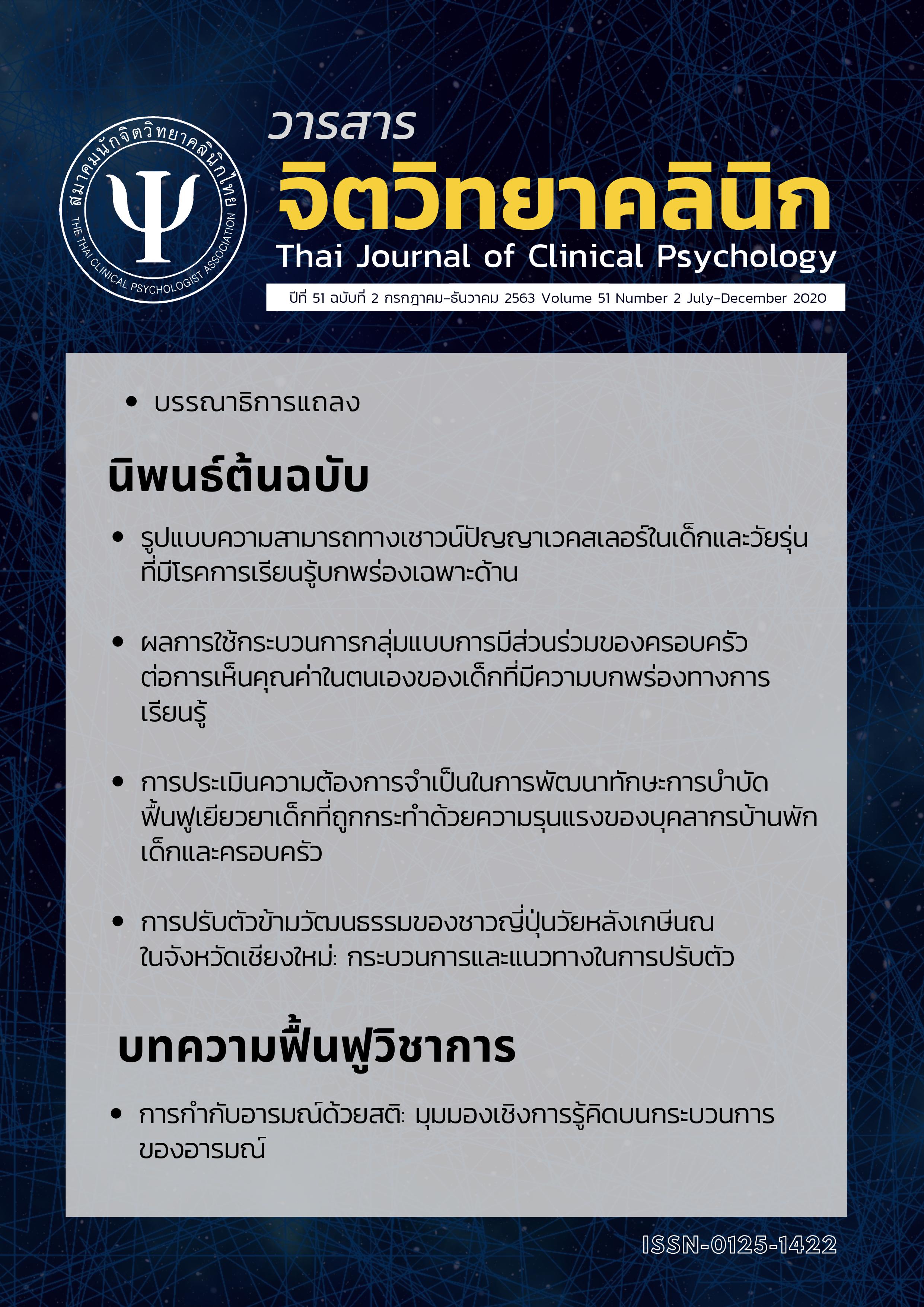The Effect of the Family Participation Group Process on Self-Esteem of Children with Learning Disabilities
Main Article Content
Abstract
Objective : This study is a development of self-esteem of children with learning disability through the
family participation process program.
Materials and methods : The samples were students with learning disabilities who are studying in
grade 3 - 6 diagnosed as learning disabilities. In this study, the total number of samples was 24 persons
or 12 pairs (1 parent and 1 child), divided into 2 groups, 6 pairs in each group, divided into experimental
group and control group. And using a simple random sampling method by drawing lots into the
experimental and control groups. The experimental group will participate in the Family Participatory
Program and the control group will be assigned to the Individual Education Management Program.
(Individualized Education Program). The research tools included researcher’s family participation group
process program and self – esteem inventory form. The statistical methods used for data analysis
Wilcoxon Signed Rank test and Mann Whitney U test.
Results : The experimental group had a higher level of self – esteem at statistical significance of .05.
But in the control group there was no significant difference and when comparing the self-esteem level
between the experimental group and the control group after joining the program. It was found that the
experimental group had higher self – esteem than the control group with statistical significance of .05.
Conclusion : The results of this research reflects that family participation process can develop
self-esteem in children with learning disabilities.
Article Details
เรื่องที่ลงตีพิมพ์ในวารสารจิตวิทยาคลินิกแล้วถือเป็นลิขสิทธิ์การเผยแพร่โดยวารสารจิตวิทยาคลินิกแต่เพียงผู้เดียว การตีพิมพ์หรือเผยแพร่ซ้ำในที่อื่นต้องได้รับอนุญาตจากกองบรรณาธิการวารสารฯ
References
admin/images/groupreview/groupreview0000360.pdf
จันทร์ฉาย พิทักษ์ศิริกุล. (2532). ผลของการจัดโปรแกรมการฝึกความกล้าแสดงออกต่อความรู้สึกเห็นคุณค่าในตนเองของนักเรียน
ชั้นมัธยมศึกษาปีที่ 3. จุฬาลงกรณ์มหาวิทยาลัย,กรุงเทพฯ.
จินดาพร แสงแก้ว. (2541). การเปรียบเทียบผลของการใช้กิจกรรมกลุ่มสัมพันธ์แบบมาราธอนเพื่อพัฒนาความภาคภูมิใจในตนเองของเด็กบ้านอุปถัมถ์ มูลนิธิสร้างสรรค์เด็ก. (ปริญญานิพนธ์ปริญญามหาบัณฑิต). มหาวิทยาลัยศรีนครินทรวิโรฒ, กรุงเทพฯ.
ชนิดา สุวรรณศรี. (2542). ผลของกิจกรรมกลุ่มที่มีต่อการเห็นคุณค่าในตนเองของเยาวชนผู้ติดยาเสพติด ( วิ ท ย า นิ พ น ธ ์ ป ริ ญ ญ า ม ห า บั ณ ฑิ ต ). มหาวิทยาลัยเกษตรศาสตร์, กรุงเทพฯ
ดารณี ศักดิ์ศิริผล. (2555). การพัฒนาความสามารถอ่านและเขียนคำที่มีตัวสะกดตรงตามมาตราของนักเรียนชั้นประถมศึกษาปีที่ 1-3 ที่มีความบกพร่องทางการเรียนรู้โดยใช้วิธี P - Lips: รายงานการวิจัย = The development of reading and spelling skill for the students with learning disabilities in pratom suksa I to III by P - Lips method. มหาวิทยาลัยศรีนครินทรวิโรฒ, กรุงเทพฯ.
เด่นเดือน ภู่ศรี. (2556). ผลของโปรแกรมฟื้นฟูสมรรถภาพโดยการมีส่วนร่วมของครอบครัวต่อการเห็นคุณค่าในตนเองและความเข้มแข็งในการมองโลกของผู้เสพแอมเฟตามีน (วิทยานิพนธ์วิทยาศาสตร์มหาบัณฑิต). มหาวิทยาลัยมหิดล, กรุงเทพฯ.
ทวีศักดิ์ สิริรัตน์เรขา. (2556). แอลดี-ความบกพร่องในก า ร เ รี ย น รู ้. สื บ ค ้ น จ า ก h t t p s : / /www.happyhomeclinic.com/sp04-ld.htm
ปุริมาพร แสงพยับ. (2553). ผลการให้คำปรึกษาแบบกลุ่มตามทฤษฎีเผชิญความจริงที่มีต่อการตระหนักรู้ และการเห็นคุณค่าในตนเองของนั ก ศึ ก ษ า ม ห า วิ ท ย า ลั ย เ ก ษ ม บั ณ ฑิ ต
(วิทยานิพนธ์ปริญญามหาบัณฑิต). มหาวิทยาลัยรามคำแหง, กรุงเทพฯ.
วรวรรณ ชัยยา. (2558). การส่งเสริมการเห็นคุณค่าในตนเองของเด็กที่มีความบกพร่องทางการเรียนรู้โดยใช้เทคนิคโทรทเซอร์ (สารนิพนธ์ปริญญามหาบัณฑิต). มหาวิทยาลัยเชียงใหม่, เชียงใหม่.
วรวุฒิ เจริญวุฒิวิทยา. (2546). การวิเคราะห์องค์ประกอบเชิงยืนยันความภูมิใจในตนเองของนักศึกษาระดับประกาศนียบัตรวิชาชีพสาขาช่างอุตสาหกรรม (วิทยานิพนธ์ปริญญามหาบัณฑิต). มหาวิทยาลัยบูรพา, ชลบุรี.
ศันสนีย์ ฉัตรคุปต์. (2544). ความบกพร่องในการเรียนรู้หรือแอลดี : ปัญหาการเรียนรู้ที่แก้ไขได้. กรุงเทพฯ: วัฒนาพานิช.
สถาบันราชานุกูล. (2559). การสำรวจสถานการณ์ระดับสติปัญญา (IQ) และความฉลาดทางอารมณ์(EQ) เด็กไทยวัยเรียนและปัจจัยที่เกี่ยวข้อง. สืบค้นจาก https://th.rajanukul.go.th/
preview-5122.html
สำนักงานบริหารการศึกษาพิเศษ. (2560). รายงานจำนวนนักเรียนพิการเรียนรวม รวมทุกสำนักงานเขตพื้นที่การศึกษา. สืบค้นจาก http://specialbasic.specialset.bopp.go.th/specialbasic/download/student_2559_2_class_de.pd
สุใจ ส่วนไพโรจน์. (2556). การปรึกษาเชิงจิตวิทยาแบบกลุ่มและทักษะการปฏิบัติ. สงขลา: ภาควิชาจิตวิทยาและการแนะแนว คณะศึกษาศาสตร์ มหาวิทยาลัยสงขลานครินทร์.
สุวิมล สนั่นชาติวณิช. (2551). รายงานผลของโปรแกรมฟื้นฟูสมรรถภาพโดยการมีส่วนร่วมของครอบครัวต่อการเห็นคุณค่าในตนเองและความเข้มแข็งในการมองโลก ของผู้เสพแอมเฟตามีน. ใน การประชุมวิชาการยาเสพติดแห่งชาติ. ตรัง; โรงพยาบาลหห้วยยอดจังหวัดตรัง.
อุมาพร ตรังคสมบัติ. (2544). จิตบำบัดและการให้คำปรึกษาครอบครัว (พิมพ์ครั้งที่5). กรุงเทพฯ: ศูนย์วิจัยและพัฒนาครอบครัว.
Abraham, C., Gregory, N., Wolf, L., & Pembeerton, R. (2002). Self-esteem, stigma and community participation amongst people with learning difficulties living in the community. Journal of Community and Applied Social Psychology, 12(6), 430-443.
Alesi, M., Rappo, G., & Pepi, A. (2012). Self-Esteemat School and Self-Handicapping in Childhood: Comparison of Groups with Learning Disabilities. Psychological
Reports, 111(3), 952-962.
Bullock, B. M., Bank, L., & Burraston, B. (2002). Adult sibling expressed emotion and fellow sibling deviance: A new piece of the family process puzzle. Journal of Family Psychology, 16(3), 307.
Cortiella, C., & Horowitz, S. H. (2014). The state of learning disabilities: Facts, trends and emerging issues. New York: National center for learning disabilities, 25, 2-45.
Herz, L., & Gullone, E. (1999). The relationship between self-esteem and parenting style: A cross-cultural comparison of Australian and Vietnamese Australian adolescents. Journal of cross-cultural psychology, 30(6), 742-761.
Hutchison, E. D. (2018). Dimensions of human behavior: The changing life course: Sage Publications.
Lahane, S., Shah, H., Nagarale, V., & Kamath, R. (2013). Comparison of self-esteem and maternal attitude between children with learning disability and unaffected siblings. The Indian Journal of Pediatrics, 80(9), 745-749.
Pope, A. W., McHale, S. M., & Craighead, W. E. (1988). Self-esteem enhancement with children and adolescents: Pergamon Press.
Rezaei-Dehaghani, A., Paki, S., & Keshvari, M. (2015). The relationship between family functioning and self-esteem in female high school students of Isfahan, Iran, in 2013–2014. Iranian journal of nursing andmidwifery research, 20(3), 371.

